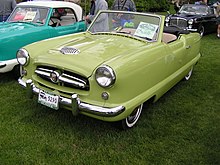| Metropolitan | |
|---|---|
 1957 Metropolitan | |
| Overview | |
| Manufacturer | Austin (BMC) |
| Also called |
|
| Production | October 1953–April 1961 |
| Model years | 1954–1962 |
| Assembly | Longbridge plant, Birmingham, West Midlands, England |
| Designer | William J. Flajole |
| Body and chassis | |
| Class | |
| Body style |
|
| Layout | FR layout |
| Powertrain | |
| Engine | |
| Transmission | 3-speed manual |
| Dimensions | |
| Wheelbase | 85 in (2,159 mm) |
| Length | 149.5 in (3,797 mm)[1] |
| Width | 61.5 in (1,562 mm) |
| Height | 54.5 in (1,384 mm)[2] |
| Curb weight | 1,785–1,890 lb (810–857 kg) (base) |
The Nash Metropolitan is an American automobile assembled in England and marketed from 1953 until 1962.
It conforms to two classes of vehicle: economy car[3] and subcompact car.[4][5][6][7][8] The Metropolitan is considered a "subcompact", but this category was not yet in use when the car was made.[9] At that time, it was categorized as a "small automobile" as well as an "economy car".
The Metropolitan was also marketed as a Hudson model when Nash and Hudson merged in 1954 to form the American Motors Corporation (AMC). The Nash and Hudson lines were phased out in favor of the Rambler line, and in 1957, the Metropolitan became a standalone brand and was badged with a stylized 'M' on hubcaps and grille. The cars were also sold in the United Kingdom and other markets.



- ^ "1954 Nash Metropolitan Foldout". oldcarbrochures.com. pp. 4–5. Retrieved 22 March 2022.
- ^ "1954 Nash Metropolitan Foldout". oldcarbrochures.com. pp. 7–10. Retrieved 22 March 2022.
- ^ Gross, Ken. "Modern Classic: Nash Metropolitan". automedia.com. Archived from the original on 12 February 2012. Retrieved 22 March 2022.
....in 1950–51, Nash circulated 250,000 questionnaires nationally asking: "Does American want the economy car"...
- ^ "1954–1962 Metropolitan". How Stuff Works. 23 October 2007. Retrieved 22 March 2022.
the... president of Nash-Kelvinator Corporation decided to market what would ultimately be called a 'subcompact'...
- ^ Kunz, Bruce (7 April 2008). "Creature comfort options were plentiful on 1955 Rambler line". St. Louis Post-Dispatch. Archived from the original on 14 February 2016. Retrieved 22 March 2022.
the Nash Metropolitan, a sub compact...
- ^ Foster, Patrick R. (Fall 2000). "With malice toward none". Forward – A Walter P. Chrysler Newszine. p. 39.
Nash introduced...the subcompact Metropolitan
- ^ Rooney, Robert K. (11 January 2008). "The original smart car". The Calgary Herald. Archived from the original on 22 July 2012. Retrieved 22 March 2022.
Nash's venture into the sub-compact market
- ^ "Micro cars set to draw mega interest at Florida's preeminent collector car event" (Press release). RM Auctions. 12 December 2007. Archived from the original on 15 July 2011. Retrieved 22 March 2021.
...an iconic, subcompact 1958 Nash Metropolitan ...
- ^ Foster, Pat (October 2005). "Developing the Metropolitan". Hemmings Classic Car. Retrieved 22 March 2022.
... Mason began to explore the idea of developing a truly small car, the size of what today we'd call a subcompact.